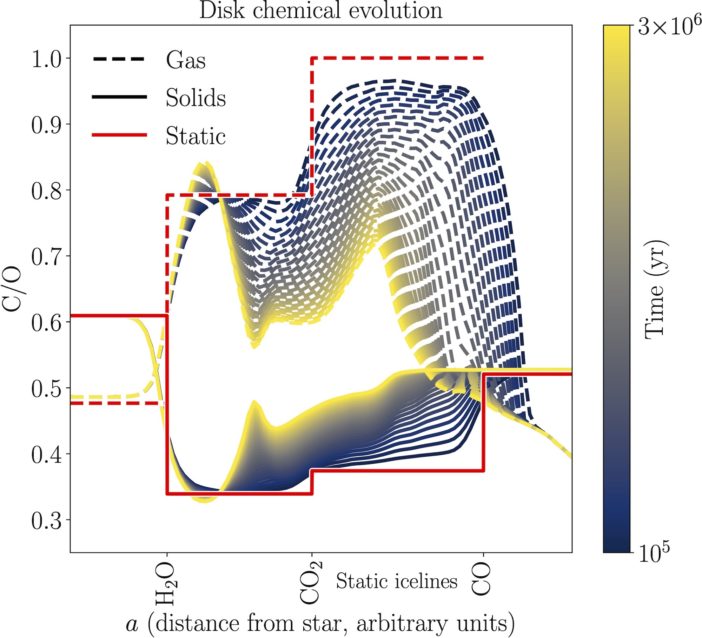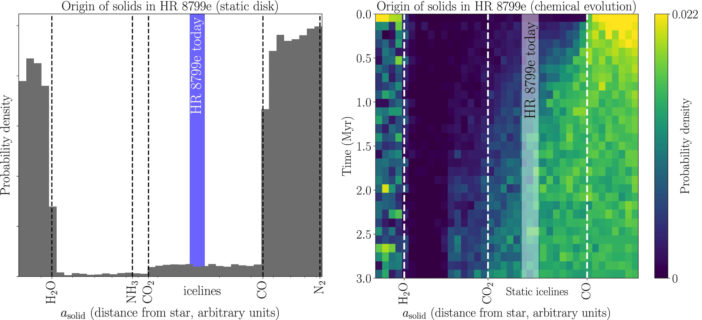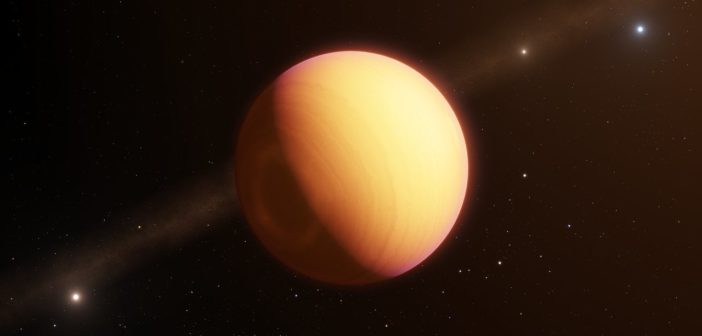Editor’s Note: Astrobites is a graduate-student-run organization that digests astrophysical literature for undergraduate students. As part of the partnership between the AAS and astrobites, we occasionally repost astrobites content here at AAS Nova. We hope you enjoy this post from astrobites; the original can be viewed at astrobites.org.
Title: Interpreting the Atmospheric Composition of Exoplanets: Sensitivity to Planet Formation Assumptions
Authors: Paul Mollière et al.
First Author’s Institution: Max Planck Institute for Astronomy
Status: Published in ApJ
One of the biggest questions that drive astronomers is “Where did we come from?” Whether studying the earliest hours of the universe, the formation of stars and galaxies, or the compositions of planets orbiting distant stars (exoplanets), astronomers use observations of the universe to piece together a story that describes how things got to be the way they are. For the better part of two decades, exoplanet-focused astronomers have attempted to measure the molecules that make up the atmospheres of exoplanets in order to better understand how those planets formed. Understanding how many different exoplanets form can then help astronomers understand how our own solar system formed, and how Earth, and life itself, came to be.
There are a few problems that are preventing astronomers from making those connections reliably, however. Well, a lot of problems, actually. For one, exoplanet atmospheres are hard to measure, but that might change soon thanks to JWST. For another, planet formation is dynamic, and different planet formation models can produce dramatically different atmospheres. Today’s article presents a new framework for tackling this second problem and shows how different planet formation models can lead to different interpretations about how the exoplanet HR 8799e formed.
Making Planets Is Complex!
Planet formation is a dense topic (interesting astrobites include this one, this one, and an old review bite), but in the broadest strokes: planets form from disks of gas and dust called protoplanetary disks that surround young stars. Giant planets, like Jupiter, form when their rocky cores grow massive enough (by smashing into other rocks) to vacuum up gas from the protoplanetary disk.
When and where a forming planet vacuums up its gas will affect which molecules end up in its atmosphere. This is because, as you go out further from the central star in a disk, the disk gets colder, and molecules that were gaseous can condense down into ices and become solid. The locations within a protoplanetary disk where molecules condense into solids are called ice lines (see Figure 1).
About ten years ago, a study suggested that the ratio of carbon atoms to oxygen atoms in an exoplanet’s atmosphere could indicate which ice lines it formed between, since the freezing out of water, carbon dioxide, and carbon monoxide changes the ratio of those two elements in the gas of the disk. This study suggested that if the carbon-to-oxygen (C/O) ratio of an exoplanet could be measured, astronomers could tell where in the protoplanetary disk it formed.
As discussed in today’s article, things aren’t so simple. One example the article uses is the fact that as the exoplanet is forming, the disk chemistry is changing — the disk is heated by the newly born star and disrupted by the newly born planet. Figure 1 shows the C/O ratio throughout the disk for the static model introduced in the previous study, as well as snapshots in time of a disk evolving as, for instance, carbon monoxide is turned into carbon dioxide by heat from the star.
Flipping the Table (or, “Formation Model Inversion”)
This quest isn’t hopeless: today’s article presents a framework in which the different assumptions and uncertainties mentioned above could be compared with available atmospheric measurements in order to meaningfully connect observations and model predictions.

Figure 1: The C/O ratio within a protoplanetary disk as a function of distance and time. The x-axis plots distance (a) from the central star, marking the ice lines of water, carbon dioxide, and carbon monoxide, while the y-axis plots the C/O ratio. The color gradient of the lines, from dark blue to bright yellow, indicates the progression in time of a model that assumes that the chemicals in the disk evolve as they are heated by the central star. This plot shows that it might not be simple to predict where in a protoplanetary disk a planet formed based on its C/O ratio, as there can be different values on the x-axis for one value on the y-axis. [Mollière et al. 2022]
Where Did HR 8799e Get Its Carbon and Oxygen?
HR 8799e is the innermost gas giant planet in a system of four directly imaged giant planets. In today’s article, the authors use their new framework on HR 8799e and demonstrate how including the time evolution of the chemicals in the protoplanetary disk — and the movement of small rocks through the disk during planet formation — change the predicted formation history of the planet.
HR 8799e’s atmosphere was previously studied using data from the Very Large Telescope Interferometer (VLTI) GRAVITY instrument. That study found the planet’s C/O ratio to be 0.6 (that is, 6 carbon atoms for every 10 oxygen atoms). The authors of today’s article use this measurement and their new analysis framework to compare the simplistic model of a protoplanetary disk and a chemically evolving disk.
The authors find that the simple model predicts that HR 8799e formed either within the water ice line (very close to its host star) or outside the carbon monoxide ice line (far away). Either way, the planet now orbits in the middle of these two extremes, indicating that it must have migrated from where it originally formed (see Figure 2, left panel). However, the chemically evolving disk model makes a slightly different prediction, indicating that as the disk chemically evolved, the most likely formation location of HR 8799e moved inward from beyond the carbon monoxide ice line to within it (see Figure 2, right panel). This could indicate that, depending on when HR 8799e began forming relative to the disk’s chemical evolution, it might not have needed to migrate to get to its current position.

Figure 2: The origin location of HR 8799e’s C/O ratio. The left plot indicates how likely the solids comprising the planet are to have originated from a given location in the protoplanetary disk for the most simplistic model considered. The most probable locations are within the water ice line and outside the carbon monoxide ice line, but compared to the current location of HR 8799e, this appears to indicate the planet must have migrated far from where it formed. The right plot illustrates the chemically evolving disk case. While this model shows that early in time the most likely place for HR 8799e to form is the same as in the simple model case, the most likely formation location changes as the disk chemistry changes — it becomes more likely the planet could have formed within the CO ice line and migrated only a little bit to its current position. [Mollière et al. 2022]
Original astrobite edited by Lynnie Saade.
About the author, William Balmer:
William Balmer (they/them) is a PhD student at Johns Hopkins University/Space Telescope Science Institute studying the formation, evolution, and composition of giant planets, brown dwarfs, and very low-mass stars. They enjoy reading, tabletop games, cycling, and astrophotography.

